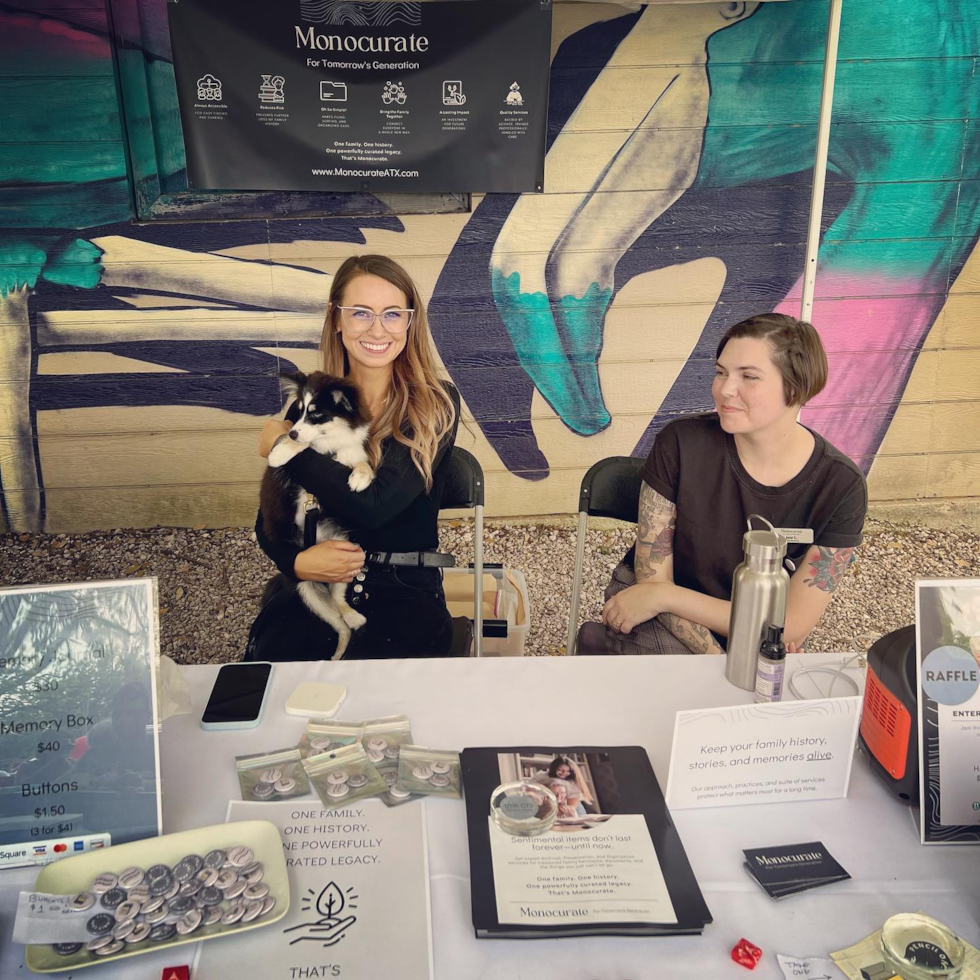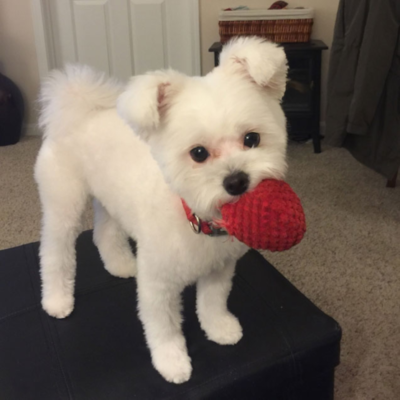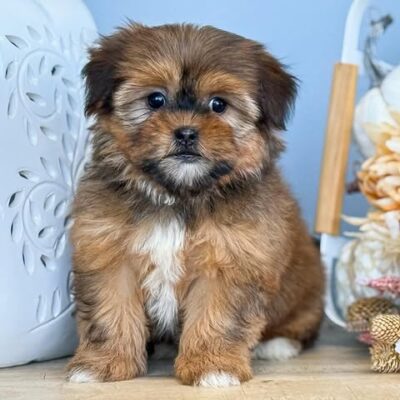
Pomskies are energetic, gregarious, and full of life. These canines are renowned for being devoted and constantly willing to provide affection and company. Their cheerful, dedicated, and upbeat nature makes them fun to be around. Pomsky puppies are energetic, quick learners, and affectionate cuddlers. They are like tiny sunshines. They have characteristic pointed ears and eyes that could melt anyone’s heart, and they usually weigh between 20 and 30 pounds and stand 10 to 15 inches tall. Pomskies are just too adorable with their sweet disposition and playful antics.
| Attribute | Details |
|---|---|
| Same As | |
| Breed Type / Mix | Hybrid / Pomeranian crossed with a Husky |
| Life Span | 13-15 yrs |
| Training | Moderate |
| Shedding | Moderate |
| Energy | High Energy |
| Temperament | Calm, Friendly, Intelligent, Sociable |
| Adult Weight | 18-30 lbs |
| Adult Height | 10-15 in |
- Pomsky dogs and puppies are social and friendly; they get along well with other dogs, pets, and children
- Vigilant, confident, and protective, the Pomsky has the ideal temperament to be an efficient guard and alarm dog
- Pomsky puppies are easy to train, eager to learn, and love to impress
- Intelligent, joyous, and fun, the Pomsky is best suited as a companion pet for families with or without children, singles, and seniors. This breed makes one of the best family dogs
- Pomsky dogs live longer, healthier lives due to hybrid vigor
- Joyful, cuddly with a sunny disposition, the Pomsky is a wonderful emotional support dog
- The Pomsky is an affectionate, fiercely loyal dog, quick to form life-long bonds and known to love unconditionally
- Pomskies are highly adaptable pups; their small size and moderate energy levels allow them to live comfortably in both small city apartments and large country-side homes
- With their thick Pomsky coat, these pups are comfortable in cold climates and tolerate warm weather

The Pomsky, which resembles a small wolf, has a small to medium stature, weighing 20 to 30 pounds on average and standing 10 to 15 inches tall. These fiercely adorable small dogs have a well-proportioned body, a medium-length muzzle, charming pointy elfish ears, a bushy tail worn curled over the back, and almond-shaped sparkly eyes.
The Pomsky can have light brown to light blue eyes or different colored eyes, with one blue and the other brown. The Pomsky sports a medium-to-long soft fluffy coat that can come in a variety of colors and color combinations, such as black and white, blue and white, gray and white, brown or reddish brown, blue, white, red, or tan, with various patterns and markings.
The breed’s coat is thick, offering insulation during hot and cold weather. With a thick coat also comes some shedding; although they don’t shed a lot, Pomskie dogs are seasonal shedders.
Highly devoted with a big personality and lots of love to give, the Pomsky is an ideal family companion pet, as many dog owners can attest. Pomsky pups are just as adorable and cuddly as they are feisty and brave. They love to bounce around and play just as much as they love to cuddle and relax on the couch. Pomskies are fun, lively, and full-of-surprises comedians who love to entertain and impress. They enjoy having all eyes on them and preferably audiences that will cheer, praise, and applaud a well-performed trick.
Pomskies are natural-born explorers. They like to investigate every new territory they discover, and they enjoy meeting new people. Pomsky dogs are moderately energetic, friendly, and playful. They love to be active, especially if games of fetch, chases around the yard, or hiking adventures are involved. Running and playing in the snow during winter and splashing in the water for a cool-off during summer are among the Pomsky’s favorite activities.
Clever, sporty, and athletic, the Pomsky is known to enjoy and excel at canine sports such as rally agility and obedience. Training Pomsky puppies requires determination, as they are more on the enthusiastic side. Combining training with playtime and including lots of praises and yummy rewards will be most effective when training a Pomsky. The Pomsky dogs are not considered to be overly dependent. A long nap and a chew toy will keep them happy and content when they are alone.
Professional grooming
Pomskies are low maintenance when it comes to grooming. Their coats require weekly brushing to keep them tangle-free and avoid matting. Pomskies have a strong affinity for water and are eager to splash in any puddle or pool. Therefore, avoid bathing them too frequently with dog shampoo. Pomskies have natural oils that protect their coats and skin. We do not recommend bathing them too often as it can lead to dry skin and rashes. Two or three baths every year will suffice.
We recommend cleaning their ears, clipping their nails, and brushing their teeth at least once every few months. These Husky and Pomeranian mix dogs may shed occasionally, necessitating more frequent brushing during shedding seasons.
Exercise Needs
Pomskies are energetic dogs. They love to spend their energy running, playing canine games like chasing or fetching a ball, catching a Frisbee, swimming, and hiking. We recommend walking Pomskies for an hour daily to keep them healthy, happy, and fit. It is also important to provide them with interactive toys and plenty of indoor playtime so they don’t get bored.
Are you curious about the appropriate time for your puppy to play outside? Check out our guide on When Can Puppies Go Outside?
Health
Pomsky puppies are a designer crossbreed, hybrids of a Pomeranian crossed with a Siberian Husky. They can be prone to some of the common health issues that their parents suffer from, although they are known to enjoy better health and fewer problems thanks to hybrid vigor. Some of the issues that the Pomeranian and Husky are known to have include allergies, cataracts, skin problems, and dental problems. These are the same health issues that Pomskies might suffer from as well.
Lifespan
A Pomsky dog typically lives 13 to 15 years, but they can live longer with proper raising and care. You must schedule regular vet checks to maintain your health and provide a well-balanced diet.
Training
Pomskies are intelligent dogs, but they can occasionally be stubborn regarding training. When you meet their motivation requirements, you can easily train them. They respond best to short and fun training sessions and lots of treats and praise.
Leash training and socialization should be taken on early when Pomskies are still young puppies, as they tend to grow more stubborn later on and might not accept the leash so easily.
Pomskies are friendly dogs. They are open to meeting new people and making new friends with other pets. Gradually introducing them to new places, people, and experiences when they are puppies will help them become well-rounded adults.
Pomskies are independent dogs. They are not generally prone to separation anxiety and can be left alone for up to eight hours.
Early training is key to shaping your Pomsky’s behavior.
The Pomsky, known as the Pomeranian Husky or Husky Pom, is a captivating and sought-after designer hybrid breed that emerged in the United States in 2009. The Pomsky, an exquisite blend of purebred Pomeranian and purebred Siberian Husky, has captured hearts globally with its striking wolf-like look, endearing temperament, and unwavering loyalty. The Pomsky, a contemporary designer breed, boasts a relatively short history. Exploring the rich history of the Pomeranian and Siberian Husky parent breeds allows us to gain valuable insights into the unique characteristics of the Pomsky designer breed.
The Pomeranian, affectionately referred to as the Pom or Loulou de Pomeranie, proudly holds the title of the tiniest member of the illustrious Spitz family. The Spitz, a sledge dog hailing from the Arctic region, is known for its strength, resilience, and impressive size, making it a true powerhouse in the world of working dogs. The ancestors of the Pomeranians journeyed from the Arctic to Pomerania. This area now spans parts of Poland and Germany, where it was selectively bred to a smaller size and rebranded as the Pomeranian. Spanning from Pomerania to the far reaches of Europe and the United States, the Pomeranian has enjoyed a life of luxury as a cherished companion among the elite, including aristocrats, nobles, and royal families. Queen Victoria, an ardent admirer of the breed, skillfully reduced the size of the Pomeranian by half during her reign, ultimately giving rise to the charmingly petite Pomeranian we know and love today.
The Siberian Husky is thought to be among the oldest dog breeds globally—possibly even the oldest. The Siberian Husky, a robust and tenacious working dog hailing from the icy expanses of Siberia, was originally bred by the Chukchi tribe to serve as a loyal guard dog, a cherished companion, and a skilled sledge dog. Originally brought to Alaska for sledge racing, the Siberian Huskies quickly captured the spotlight by winning race after race. The Huskies, originating from Alaska, made their mark globally as cherished companion pets and formidable working dogs. Currently, the Siberian Husky is the most popular breed across North America. Discover them shining as iconic stars in films and television and extraordinary champions in dog shows and sports.
Pomsky puppies are bred through various generations, including F1, F1B, and F2. This is implemented to enhance control over size, coat colors, and physical characteristics. F1 Pomsky puppies come from the delightful union of a Pomeranian and a Siberian Husky, whereas F1b Pomsky puppies are created by backcrossing an F1 Pomsky with a Pomeranian. Every Pomeranian Husky mix radiates charm in its delightful way.
What is a Teacup Pomsky? A Teacup Pomsky is a miniature hybrid dog bred from a Pomeranian and a Husky (or occasionally a Siberian Husky mix), known for its compact size and striking appearance.
Are Teacup Pomsky puppies hypoallergenic? Although no dog is completely hypoallergenic, many owners find that Teacup Pomskies shed minimally, making them more suitable for people with mild allergies.
How much do Teacup Pomsky puppies typically weigh? When fully grown, these puppies generally weigh between 5 and 12 pounds, depending on genetics and diet.
What is the typical lifespan of a Teacup Pomsky? With proper care and a healthy lifestyle, Teacup Pomskies usually live between 12 and 15 years.
How energetic are Teacup Pomskies? They are lively and energetic, enjoying both indoor play and short daily walks, yet they can adapt well to quieter indoor lifestyles.
Do Teacup Pomsky puppies need a lot of exercise? While they are active, their exercise needs are moderate, typically satisfied with daily walks and play sessions.
Are Teacup Pomskies suitable for apartment living? Yes, their small size and moderate exercise requirements make them great companions for apartment living.
How often do Teacup Pomsky puppies require grooming? They need regular grooming including brushing to prevent matting, along with periodic baths and nail trims.
Can Teacup Pomskies be trained easily? They are intelligent and eager to please, so positive reinforcement training techniques work well, though consistency is key.
What should I feed my Teacup Pomsky puppy? A high-quality, small-breed puppy food that is balanced in protein, fat, and carbohydrates is recommended, though a vet can advise based on your puppy’s specific needs.
Are Teacup Pomsky puppies good with children? Yes, with proper socialization they tend to be affectionate and playful, though their delicate size means supervision is recommended around very young children.
How should I prepare my home for a Teacup Pomsky puppy? Puppy-proof your home by removing hazardous small objects, setting up a safe play area, and providing a cozy space for the puppy to rest.
Do Teacup Pomsky puppies require special veterinary care? Routine veterinary care is essential; regular check-ups, vaccinations, and dental care will help ensure they remain healthy.
How do Teacup Pomskies socialize with other pets? Early socialization is crucial; they usually get along well with other small pets if introduced gradually in a controlled environment.
What is the temperament of a typical Teacup Pomsky? They are typically friendly, curious, and intelligent, with a mix of playful energy and calm affection towards their owners.
How quickly do Teacup Pomsky puppies mature? They tend to mature faster than larger breeds, with noticeable personality traits emerging within the first few months.
Can I breed a Teacup Pomsky to produce more miniatures? Breeding practices for Teacup Pomskies should be handled responsibly; consult with a reputable breeder to discuss health, genetics, and breeding ethics.
Do Teacup Pomsky puppies have any common health issues? They may be prone to conditions such as dental issues, patellar luxation, and respiratory problems, so proper health screenings and regular vet visits are important.
What are the benefits of owning a Teacup Pomsky? They offer a charming combination of a striking appearance, manageable size, and a friendly personality, making them an ideal companion for various lifestyles.
How can I learn more about a specific Teacup Pomsky puppy before purchase? Detailed information, including health records, lineage, and care instructions, is available on each puppy’s listing on our website; you can also contact our team for additional insights.




















